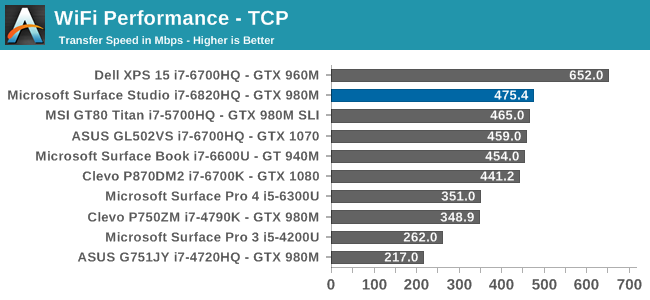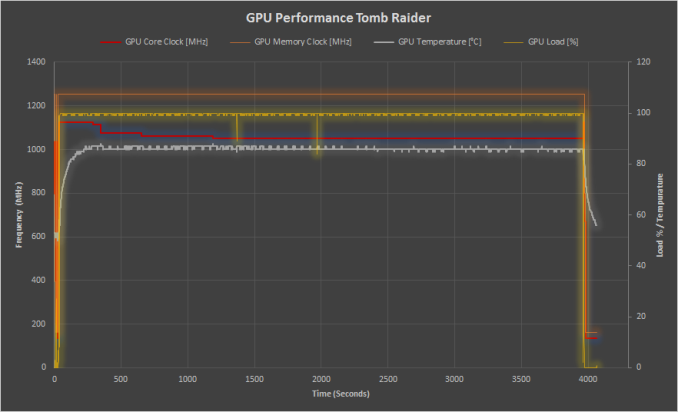The Microsoft Surface Studio Review
by Brett Howse on January 20, 2017 8:00 AM EST- Posted in
- Desktop
- Microsoft
- Surface
- Surface Studio
Wireless
Microsoft has stuck with it’s tried and tested Marvell AVASTAR 802.11ac wireless adapter for the Surface Studio, and they’ve been using this NIC for quite a while on the Surface devices, so this isn’t a surprise. Over the years, the experience with the Marvell adapter has not been the best, although recent driver updates have both improved performance, and made the adapter less prone to not finding networks to connect to.

How times have changed. The Surface Pro 4 in the above graph has the same network adapter, but you can see how far Marvell has come with the drivers. It has been solid so far in regards to connections as well, and hopefully that doesn't change. The Surface Book, with the same adapter, sometimes needs to be restarted to fix the networking even to this day.
The Surface Studio also has the Intel I219-LM Gigabit Ethernet adapter, for those that prefer a wired network connection. It does provide a better experience if you do have a cable handy, since even the best 3x3 802.11ac cards can’t really compete with Gigabit wired.
Audio
When it comes to audio, Microsoft had to put some extra work into the Surface Studio to ensure that the audio experience wasn’t impacted by too severely by moving the display. A lot more engineering went into this than you would expect, and the Surface Studio features a total of seven speakers. Apparently the Surface team decided to go big, or go home, so they fit four speakers into a downward firing grille at the bottom of the display, plus there are two additional speakers in the base. The final speaker is a subwoofer to help out on the low frequencies.
 Four of the Studio speakers are on the bottom edge of the display, and another two plus a sub are in the base
Four of the Studio speakers are on the bottom edge of the display, and another two plus a sub are in the base
The sound quality of the Surface Studio is far better than you would expect for a small, tightly packed device like it is, and having the speakers in multiple locations helps out when the display gets moved into the drafting mode, since the ones on the base can now chip in to make up for the speakers on the display no longer as optimally oriented.
The system gets quite loud, and I measured a maximum of 88 dB(A) when playing music, and the sound was not distorted even at maximum volume. The subwoofer definitely helps out too, with decent frequency response even on the low end of the scale. It’s not a home theater in a box by any means, but it would likely be enough for many people.
Thermals, and Noise
Packing a PC into a space the size of the base of a Surface Studio, especially with a GTX 980M inside, is quite a challenge, but ensuring that the system does not overheat, even under load, is often too much for small devices like this. There are two fans inside the Surface Studio, and they vent out a row of slots in the black plastic underneath the computer.
When discussing the cooling with the Surface team, they were very proud of the work they had done there, especially the amount of heat dissipated per dB of noise. In order to test the thermal capabilities of the Surface Studio, the Tomb Raider benchmark was run continuously at 1920x1080 Ultra settings, which loads the GPU up to 100%.
The cooling system is very good in the Surface Studio, despite the significant heat generated by the GTX 980M. The system was able to run for five minutes at maximum boost clock of 1126 MHz before the GPU hit the thermal limit of 87°C, at which point it reduced its frequency to 1050 MHz over time, and stayed right there for the rest of the test. Perhaps the most impressive bit is that even with the GPU at 100% load, the sound pressure level with a meter over the keyboard, was just 46 dB(A), and the sound frequency is low enough that it isn’t bothersome. Microsoft did their homework on the cooling system, and the Surface Studio is solid under load.
Where it is let down though is at idle. Despite being very quiet under load, at idle, the system still produces 37.5 dB(A), and the fans constantly run. The CPU and GPU idle around 39°C, which is very reasonable, but the sound is always there. It’s not loud, but it’s always there. For me, desktop systems should be almost silent under light workloads, but that’s not the case on the Studio, which is disappointing.
The other issue on the noise side, at least on this review unit, is that there is a small amount of coil whine when the system has the display off, but it’s not yet sleeping. Most likely, this is the power supply, which is also built into the base of the Studio, coping with the reduced power demand since it isn’t driving the display backlight anymore. Once it goes to sleep, it’s not an issue, but the system does wake up periodically to update email, and the like, so even if it is sitting there asleep on the desk, occasionally the coil whine will come back, and the fans kick in.











197 Comments
View All Comments
tipoo - Friday, January 20, 2017 - link
Nice machine it seems like. People may balk at the price, but a 27 inch digitizer like a Wacom almost costs as much as this machine, and doesn't have a fairly high performance computer inside either.That said, that's also why I wish there was a touchscreen-free version for less, I'm not artsy enough to need that, but a straight iMac competitor from Microsoft could be nice.
Seems a lot of people have been griping about lack of a 1060, but the 980M is near identical in performance.
http://www.notebookcheck.net/Mobile-Graphics-Cards...
TheinsanegamerN - Friday, January 20, 2017 - link
A 1080m would be preferred, in all honesty.tipoo - Friday, January 20, 2017 - link
Probably wouldn't fit in here. The laptop TDPs aren't that much lower than the desktop TDPs in this generation as they're mostly the same chip with slightly lower clocks. The cooling design seems pretty elaborate as-is just for the 980M.DanNeely - Friday, January 20, 2017 - link
TDPs for the mobile pascal are finally out, and a mobile 1070 might fit the TDP constraints. the 980M is a 100W part, vs 80/110/150 for the mobile 1060/70/80 GPUs. It's 10W more on paper; but nVidia has been more flexible with power vs performance on mobile parts before. Worst case I'd assume that like the surface book, they'd just slap a different model number on a cut power/performance model.https://en.wikipedia.org/wiki/List_of_Nvidia_graph...
BrokenCrayons - Friday, January 20, 2017 - link
I have to wonder a little where those TDP numbers came from because GeForce.com, the cited source, doesn't appear to have them listed anyplace I could find on a cursory search. If the numbers are accurate, then when I made an off the cuff estimate about the mobile 1080 TDP being not too far off the 180W of its desktop counterpart based on heat pipe counts extrapolated from a single pipe on a Dell Latitude D630 accounting for power draw from the dual PSUs of this laptop...http://www.anandtech.com/show/10795/the-clevo-p870...
...then I was pretty darned close to reality. Anyway, if those are accurate, the TDP is HIGHLY disappointing. 75W for the 1050? What's wrong with people? A midrange GPU used to have a TDP of 20W back in the 8600M GT days and a low end 8400M GS was a mere 11W. Those GPUs were in much thicker, relatively less cramped laptops too so cooling them was easy. While it's nice to see Intel lowering TDP as technology improves, Nvidia (AMD too) continue to increase TDP despite node shrinks. It's a good time to exit computer gaming entirely and sit it out until GPUs hit the same TDP peak and then decline the CPU industry discovered years ago.
TheinsanegamerN - Friday, January 20, 2017 - link
I am curious as well. the 1050 mobile pulling 75 watt would make no sense, as the 960m was only a 55 watt part, and the 1050ti is not only faster, but fits in the same power envelope. The 1050 is much more likely to be a 30 watt part.Icehawk - Sunday, January 22, 2017 - link
Huh? Since Maxwell power #s have been getting smaller, I can run a gaming rig off a 450W supply instead of a 600+.BrokenCrayons - Monday, January 23, 2017 - link
"Since Maxwell" is not a very long history. Besides that "can run a gaming rig" isn't a very specific measurement. SLI? Low end GPU? High end GPU? CPU TDP? Number of hard drives? Other components in the system? Look a bit deeper. In addition to that, I've NEVER run a "gaming rig" off more than a 400W PSU. That doesn't mean much of anything though without me offering a long history of computer hardware configurations that can quantify power consumption. In addition to that, most people usually purchase more power supply than they really need because they're caught in marketing hype and overly conservative vendor recommendations. I've seen quite a few 1KW power supplies feeding a 95W processor and a single midrange graphics card for when 350W would be entirely sufficient.fanofanand - Monday, January 23, 2017 - link
You couldn't be more correct. I got swindled by the MOAR POWER hype on my first build, ended up with a 700W PSU to power a single HDD, a Q6600, and an 8800 GTS. I could have gotten by with 400 EASILY.BillBear - Friday, January 20, 2017 - link
A Wacom Cintiq continues to work after you purchase upgraded computer hardware, so you aren't stuck with an outdated CPU and GPU.Also, the Cintiq has double the pressure sensitivity, adds tilt sensitivity that the Surface lacks completely, and most troublesome, there is a distinct lag between moving the pen and seeing your input on the screen when compared to Wacom's professional solution.